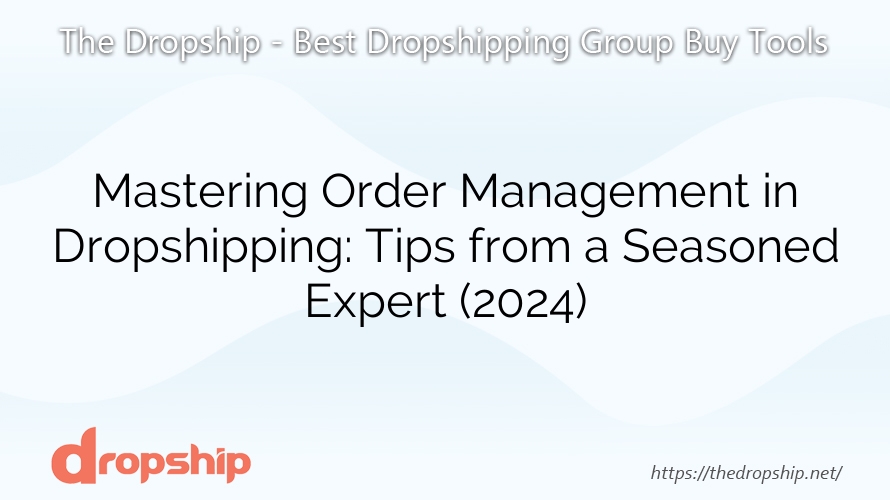Dropshipping
Mastering Order Management in Dropshipping: Tips from a Seasoned Expert (2024)
We’re dedicated to creating valuable and enjoyable content for our readers. If you want to learn more about dropshipping, check out The Dropshop.
9 Essential Steps for Efficiently Managing Dropshipping Orders
When it comes to dropshipping, one aspect that is often overlooked is the management of orders. In this article, we will guide you through the nine-step process of effectively managing your dropshipping orders. By following these steps, you can streamline your operations and ensure customer satisfaction.
Step 1: Find a Reliable Dropshipping Supplier
The foundation of successful order management lies in partnering with a trustworthy dropshipping supplier. Take the time to research and select suppliers known for their reliability, product quality, and timely fulfillment.
One way to find suppliers is by checking out curated lists, such as “The 12 Best US Dropshipping Suppliers (Fast Shipping)” or “The 15 Best Dropshipping Suppliers for Shopify Stores.” Another option is to explore your ecommerce platform’s app store for integration with reliable suppliers.
To ensure a smooth process, consider using a dropshipping supplier directory, such as SaleHoo, which connects you to a variety of vendors.
Step 2: Connect with Your Dropshipping Supplier
After finding a reliable supplier, it’s important to establish a seamless connection for order processing. Look for integration apps provided by your ecommerce platform or consider using CSV files to manually transfer order information.
For example, if you’re using Shopify, you can explore apps like Spocket or CJdropshipping for easy integration. Remember to input the correct store URL and follow the instructions to establish a connection with your supplier.
Step 3: Review and Double-Check Order Information
Before forwarding order information to your supplier, take the time to review and verify all details. Ensure accuracy in customer information, shipping addresses, and product selections to avoid any potential issues.
Step 4: Capture the Payment
Before proceeding with the order, it is crucial to capture the customer’s payment securely. Choose a reliable payment gateway, such as Shopify Payments, PayPal, or Stripe, to handle and process payments.
Step 5: Send the Order Information to Your Supplier
Once the payment is captured, promptly send the order information to your supplier. This can be done automatically through integration apps or by manually exporting the order details in a CSV file.
Step 6: Let Your Supplier Ship the Product
After providing the necessary information, step back and let your supplier handle the shipping process. Double-check that all details are correct, including the customer’s address and order specifications. If any issues arise, communicate promptly with your supplier to resolve them.
Step 7: Update the Tracking Information
To provide transparency and peace of mind to your customers, update the tracking information for their orders. Obtain the tracking number from your supplier, update it in your system, and notify your customers with instructions on how to track their orders. Consider using automation tools like Avada Email Marketing to streamline the process.
Step 8: Handle Any Shipping Delays Professionally
Shipping delays can happen due to various reasons, such as bad weather or logistical challenges. As a dropshipper, it is crucial to handle these situations professionally and communicate promptly with your customers. Be proactive, keep your customers informed, and offer solutions or concessions, such as a discount or free shipping, to maintain customer satisfaction.
Step 9: Handle Return or Refund Requests with Care
In the event of a return or refund request, focus on turning the negative experience into a positive one. Gather information about the issue to improve your store or product descriptions. Follow your store’s return and refund policy, process the refund promptly, and offer gestures of goodwill, such as discounts or future incentives, to retain customer loyalty.
Handling Out-of-Stock Items
If an item is out of stock, promptly inform your customers and offer alternative options or backorders. Use this opportunity to recommend similar products, provide discounts, or make small refunds to maintain customer satisfaction.
3 Best Tools for Managing Dropshipping Orders
Here are three highly recommended tools that can enhance your dropshipping order management:
Syncee
Syncee is an automation tool that streamlines order processing by sending new orders to your suppliers automatically. It also offers features like automated stock updates and bulk product editing.
Avada Email Marketing
Avada Email Marketing provides robust workflows for transactional and targeted emails. You can send order confirmations, shipping notifications, and abandoned cart reminders to improve customer experience and encourage repeat purchases.
BeProfit
BeProfit offers reporting tools to analyze the profitability of your dropshipping orders. It allows you to gain insights into your business’s financials and make informed decisions.
Conclusion
Efficiently managing dropshipping orders is essential for a successful business. By following the nine-step process outlined in this article and utilizing the recommended tools, you can streamline your operations and provide an excellent customer experience.
Remember, taking action is key. Implement these strategies and tools to elevate your dropshipping business to new heights. For access to the best group buy tool for dropshipping, visit The Dropshop.
Good luck on your dropshipping journey!

